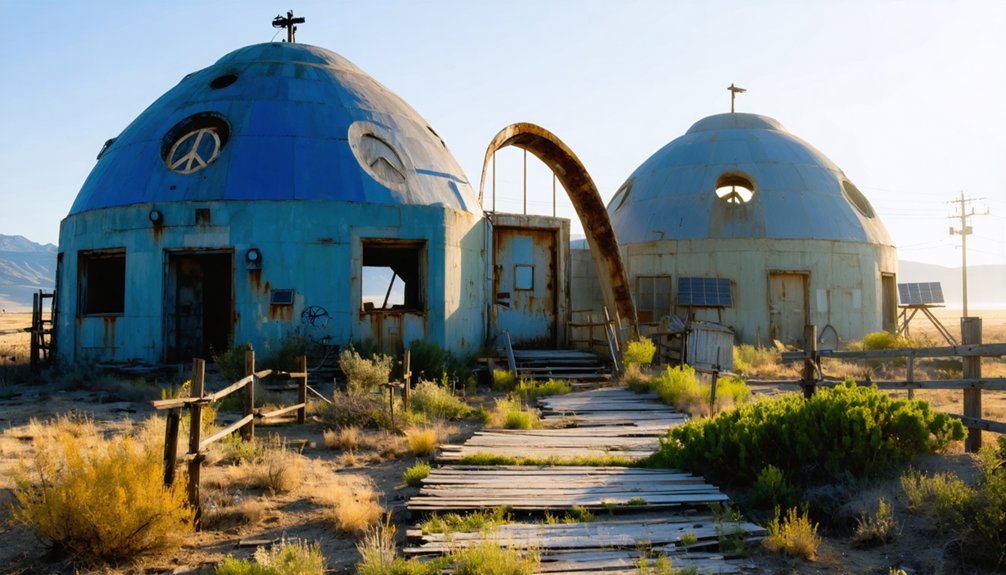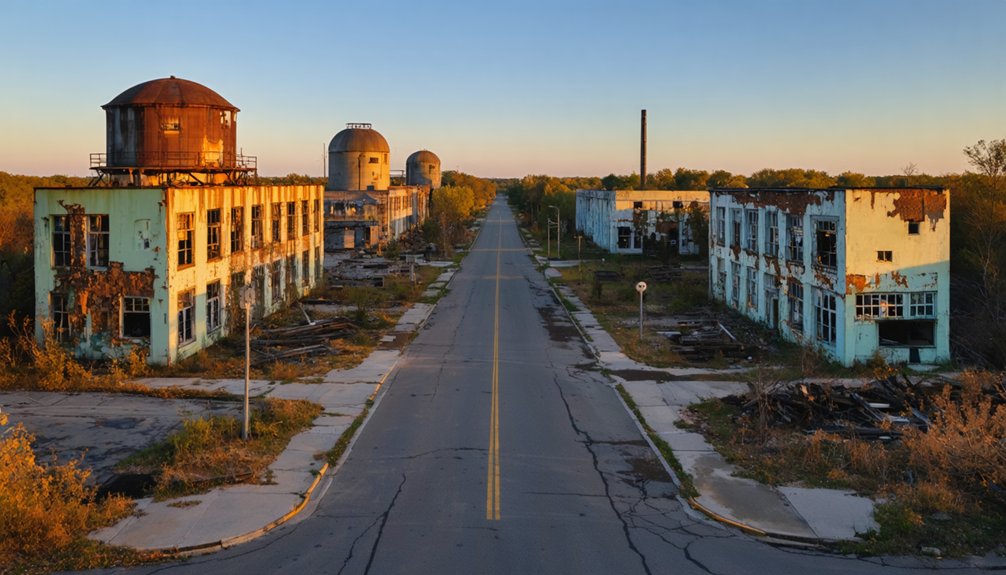You’ll discover America’s utopian heritage at five remarkable abandoned communities: Pennsylvania’s Old Economy Village, where Harmonists created industrial wealth; Ephrata Cloister, with its distinctive German architecture reflecting spiritual austerity; Massachusetts’ Brook Farm, a Transcendentalist intellectual haven; New York’s Oneida Community Mansion House, site of radical social experimentation; and Harmony Historic District, a model of German separatist self-sufficiency. These preserved sites offer tangible connections to idealistic experiments that challenged conventional American society.
Key Takeaways
- Old Economy Village in Pennsylvania offers well-preserved buildings and cemetery showcasing the Harmony Society’s prosperity from 1824-1905.
- Ephrata Cloister features distinctive Pennsylvania German architecture reflecting the ascetic lifestyle of this 1732 religious commune.
- Brook Farm in Massachusetts, though brief-lived (1841-1847), preserves remains of Transcendentalist ideals including The Hive communal building.
- Oneida Community Mansion House stands as a 93,000-square-foot testament to radical social experimentation and communal living from 1848.
- Harmony Historic District contains remnants of the original 1804 German separatist settlement, including the 1810 Tower Clock and community cemetery.
Old Economy: Where Harmonist Prosperity Still Echoes
While walking through the preserved brick buildings of Old Economy Village near Ambridge, Pennsylvania, you’ll encounter the third and final settlement of the Harmony Society, a remarkable experiment in communal living established in 1824.
The Harmonist Legacy remains tangible in the Great House with its arched wine cellar, sturdy dwellings, and well-planned cemetery—all evidence of their economic prosperity.
The ghosts of German industry haunt every corner, from vaulted cellars to orderly graves—testaments to communal wealth expertly cultivated.
Under George Rapp’s leadership and Frederick Rapp’s financial acumen, this Christian communal group implemented Communal Innovations that predated Marxism, combining pietistic religious practices with industrial ambition. The Society formally established itself when members signed articles of association on February 15, 1805, creating their framework for communal living.
Their economic model—pooling assets for collective benefit while practicing celibacy and pacifism—generated substantial wealth through agriculture, manufacturing, and shrewd investments. Before establishing Old Economy Village, they had already created and later sold settlements in Harmony, Pennsylvania and New Harmony, Indiana.
Though the Society dissolved in 1905 after membership dwindled, their experiment in utopian economics still offers powerful lessons in communal self-sufficiency.
Ephrata Cloister: Pennsylvania’s Mystical Monastic Haven
The mystical allure of Ephrata Cloister predates even Old Economy Village by nearly a century, establishing itself as one of America’s earliest religious utopian experiments. Founded in 1732 by German Pietist Johann Conrad Beissel, this Lancaster County haven combined rigorous spiritual practices with communal living arrangements that separated celibate and non-celibate members.
The community’s distinctive Pennsylvania German architecture reflects their ascetic devotion to preparing for Christ’s return. Members adhered to a strict vegetarian diet as part of their disciplined lifestyle. Their religious devotion extended to sleeping on 14-inch wooden boards with wooden block pillows, emphasizing their commitment to an austere existence.
When you visit, you’ll discover:
- Preserved monastic buildings including the Sisters’ House (Saron) and Meetinghouse (Saal)
- Examples of Frakturschriften folk art and remnants of their prolific printing press
- Cemetery grounds where Revolutionary War soldiers lie buried, proof of the Cloister’s service as a wartime hospital
Brook Farm: Transcendentalist Dreams in Massachusetts
Nestled in the pastoral landscape of West Roxbury, Massachusetts, Brook Farm stands as perhaps America’s most intellectually ambitious utopian experiment of the 19th century. Founded in 1841 by former Unitarian minister George Ripley and his wife Sophia, this community embodied Transcendentalist Philosophy through its radical equality and harmonious balance of mental and physical labor.
When you visit today, you’ll find only the print shop remains, alongside the poignant Gethsemane Cemetery. Yet this site once buzzed with the discourse of literary giants like Nathaniel Hawthorne and Margaret Fuller. The community centered around a central building called The Hive which served as the heart of domestic life. After the community closed, the site later served as Civil War training grounds for Union soldiers.
The community’s Cooperative Living model—where all members received equal pay regardless of gender—was revolutionary for its time. Though financial troubles and a devastating fire led to its closure in 1847, Brook Farm’s brief six-year existence left an indelible mark on American utopian thought.
Oneida Community Mansion House: New York’s Bold Social Experiment
Situated among the rolling hills of central New York, the imposing Oneida Community Mansion House represents one of America’s most controversial and intellectually ambitious social experiments of the 19th century. Founded in 1848 by John Humphrey Noyes, this remarkable 93,000-square-foot structure stands as a symbol to radical social ideals that challenged Victorian conventions.
The Oneida Community Mansion House stands as a monument to one of America’s boldest social experiments, challenging Victorian-era conventions in the quiet hills of New York.
Visit this architectural marvel to experience:
- The physical embodiment of “Bible Communism” where communal living transformed American social norms
- The historical site where “complex marriage” redefined traditional relationships among 300 members
- A fully preserved example of utopian architecture designed specifically to facilitate collective existence
Unlike many failed communes, Oneida’s legacy lives on through its continuous occupation since construction, now serving as both museum and National Historic Landmark. The South Wing, added in 1869, was the site where members practiced stirpiculture experiments, attempting to apply eugenics principles to human reproduction. The community established three successful business departments by 1870, including the production of steel traps which later evolved into the renowned Oneida silverware company.
Harmony Historic District: The German Religious Settlement That Time Forgot
While the Oneida Community in New York challenged Victorian social norms through “Bible Communism,” another American utopian experiment was unfolding to the west with distinctly different religious motivations.
In Pennsylvania’s Butler County, Johann Georg Rapp established Harmony in 1804 as a refuge for German Lutheran Separatists. These “Rappites” practiced celibacy, communal living, and shared labor—principles reflected in their sturdy Harmonist architecture.
You’ll find evidence of their disciplined lifestyle in the Great House, with its distinctive arched wine cellar, and the methodically planned town grid that survives today. The community grew rapidly to 700 members by 1810, emphasizing self-sufficiency through their agricultural and manufacturing pursuits.
Though the original society dissolved in 1905, Harmony’s National Historic Landmark status preserves this remarkable experiment in religious freedom. Like many utopian societies of this era, the Harmonist community faced challenges with collective ownership that contributed to eventual internal tensions.
The cemetery, containing over 100 graves, and the 1810 Tower Clock stand as silent witnesses to America’s rich history of utopian communities.
Frequently Asked Questions
Can Visitors Experience Overnight Stays in Any Utopian Community Buildings?
Yes, you’ll find overnight accommodations at Historic Rugby Village and the Oneida Community Mansion House, offering immersive visitor experiences in authentic utopian community buildings with preserved period features.
What Happened to the Personal Belongings of Original Community Members?
You’ll find that personal artifacts were typically reclaimed by members during dissolution, while community heirlooms were auctioned to settle debts or distributed among members according to established documentation and inventories.
Are There Ghost Stories Associated With These Abandoned Communities?
Like shadows of dashed dreams, you’ll find rich ghost tales at Fruitlands, New Harmony, and Nashoba. You’re encountering haunted legends where whispers, footsteps, and apparitions testify to these communities’ turbulent endings.
Do Descendants of Community Members Still Live Nearby Today?
Yes, you’ll find descendants’ stories preserved around former utopian sites, with many families maintaining community ties through local historical societies and cultural preservation efforts despite their ancestors’ disbanded experiments.
Which Utopian Community Had the Most Advanced Technological Innovations?
Coltsville stands as America’s most technologically advanced utopian community, pioneering revolutionary technological advancements including assembly line manufacturing, standardized interchangeable parts, and innovative designs that transformed industrial production methods you’ll still recognize today.
References
- https://open.baypath.edu/his114/chapter/utopian-communities/
- https://www.youtube.com/watch?v=C_dUwUum2pU
- https://www.legendsofamerica.com/ah-utopias/
- https://en.wikipedia.org/wiki/Ghost_town
- https://library.sonoma.edu/research/research-guides/regional-research/notable-north-bay-people/utopians
- https://en.wikipedia.org/wiki/List_of_American_Utopian_communities
- https://fee.org/articles/the-dark-side-of-paradise-a-brief-history-of-americas-utopian-experiments-in-communal-living/
- https://en.wikipedia.org/wiki/Utopia
- https://www.atlasobscura.com/categories/utopias
- https://guides.loc.gov/chronicling-america-early-utopian-communities



